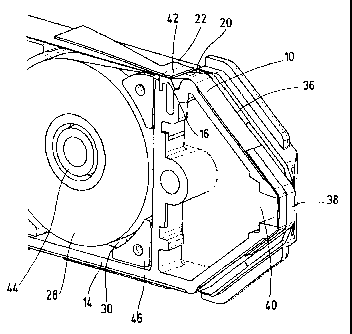Some of the information on this Web page has been provided by external sources. The Government of Canada is not responsible for the accuracy, reliability or currency of the information supplied by external sources. Users wishing to rely upon this information should consult directly with the source of the information. Content provided by external sources is not subject to official languages, privacy and accessibility requirements.
Any discrepancies in the text and image of the Claims and Abstract are due to differing posting times. Text of the Claims and Abstract are posted:
| (12) Patent: | (11) CA 2650827 |
|---|---|
| (54) English Title: | DIAGNOSTIC TEST UNIT WITH A CONTAINER FOR TEST CARRIERS |
| (54) French Title: | APPAREIL D'EPREUVES DIAGNOSTIQUES AVEC RECIPIENT POUR SUPPORTS DE BANDELETTES A EPREUVES |
| Status: | Granted and Issued |
| (51) International Patent Classification (IPC): |
|
|---|---|
| (72) Inventors : |
|
| (73) Owners : |
|
| (71) Applicants : |
|
| (74) Agent: | NORTON ROSE FULBRIGHT CANADA LLP/S.E.N.C.R.L., S.R.L. |
| (74) Associate agent: | |
| (45) Issued: | 2012-03-20 |
| (86) PCT Filing Date: | 2007-05-02 |
| (87) Open to Public Inspection: | 2007-11-15 |
| Examination requested: | 2008-10-30 |
| Availability of licence: | N/A |
| Dedicated to the Public: | N/A |
| (25) Language of filing: | English |
| Patent Cooperation Treaty (PCT): | Yes |
|---|---|
| (86) PCT Filing Number: | PCT/EP2007/054267 |
| (87) International Publication Number: | WO 2007128758 |
| (85) National Entry: | 2008-10-30 |
| (30) Application Priority Data: | ||||||
|---|---|---|---|---|---|---|
|
The invention concerns a diagnostic test unit for analysing a body fluid
comprising
a test carrier (test tape 10; test strips 12) provided with test fields (38)
for applying
the body fluid and a container (14) containing the test carrier, wherein an
opening
(18) of the container (14) is at least in some areas bordered by a seal (16).
According to the invention it is proposed that the opening (18) is screened by
a
closing foil (22) from the surroundings of the container (14) and that the
test tape
(10) or a test strip (12) to be dispensed is passed through a passage gap (20)
between the closing foil (22) and the seal (16).
L'invention concerne une unité de test de diagnostic pour analyser un liquide corporel avec un support de test (bande de test 10 ; ruban de test 12) muni de champs de test (38) destinés à l'application du liquide corporel et un récipient (14) contenant le support de test, une ouverture (18) du récipient (14) étant bordée au moins par zone par une étanchéité (16). Selon l'invention, il est proposé que l'ouverture (18) soit protégée par une feuille de scellement (22) vis-à-vis de l'environnement du récipient (14) et que la bande de test (10) ou un ruban de test à débiter (12) soit délivré à travers une fente de passage (20) entre la feuille de scellement (22) et l'étanchéité (16).
Note: Claims are shown in the official language in which they were submitted.
Note: Descriptions are shown in the official language in which they were submitted.

2024-08-01:As part of the Next Generation Patents (NGP) transition, the Canadian Patents Database (CPD) now contains a more detailed Event History, which replicates the Event Log of our new back-office solution.
Please note that "Inactive:" events refers to events no longer in use in our new back-office solution.
For a clearer understanding of the status of the application/patent presented on this page, the site Disclaimer , as well as the definitions for Patent , Event History , Maintenance Fee and Payment History should be consulted.
| Description | Date |
|---|---|
| Common Representative Appointed | 2019-10-30 |
| Common Representative Appointed | 2019-10-30 |
| Grant by Issuance | 2012-03-20 |
| Inactive: Cover page published | 2012-03-19 |
| Inactive: Final fee received | 2011-11-28 |
| Pre-grant | 2011-11-28 |
| Notice of Allowance is Issued | 2011-10-28 |
| Letter Sent | 2011-10-28 |
| Notice of Allowance is Issued | 2011-10-28 |
| Inactive: IPC assigned | 2011-10-14 |
| Inactive: IPC removed | 2011-10-14 |
| Inactive: First IPC assigned | 2011-10-14 |
| Inactive: IPC assigned | 2011-10-14 |
| Inactive: Approved for allowance (AFA) | 2011-09-29 |
| Amendment Received - Voluntary Amendment | 2011-07-05 |
| Amendment Received - Voluntary Amendment | 2011-01-31 |
| Inactive: S.30(2) Rules - Examiner requisition | 2010-07-30 |
| Inactive: Acknowledgment of national entry - RFE | 2010-06-17 |
| Correct Applicant Requirements Determined Compliant | 2010-06-17 |
| Inactive: Correspondence - PCT | 2010-04-29 |
| Correct Applicant Request Received | 2009-03-25 |
| Inactive: Cover page published | 2009-02-27 |
| Inactive: Acknowledgment of national entry - RFE | 2009-02-20 |
| Letter Sent | 2009-02-20 |
| Inactive: First IPC assigned | 2009-02-19 |
| Application Received - PCT | 2009-02-18 |
| Inactive: Declaration of entitlement - PCT | 2008-12-18 |
| National Entry Requirements Determined Compliant | 2008-10-30 |
| Request for Examination Requirements Determined Compliant | 2008-10-30 |
| All Requirements for Examination Determined Compliant | 2008-10-30 |
| Application Published (Open to Public Inspection) | 2007-11-15 |
There is no abandonment history.
The last payment was received on 2011-04-28
Note : If the full payment has not been received on or before the date indicated, a further fee may be required which may be one of the following
Please refer to the CIPO Patent Fees web page to see all current fee amounts.
Note: Records showing the ownership history in alphabetical order.
| Current Owners on Record |
|---|
| F. HOFFMANN-LA ROCHE AG |
| Past Owners on Record |
|---|
| KLAUS SCHOTTLE |
| KLAUS-DIETER SACHERER |
| RALF STEINBRUCK |
| WERNER RUHL |
| WOLFGANG DITSCHER |